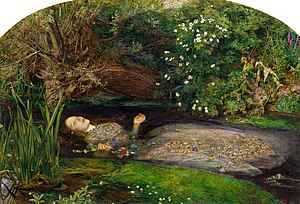floriography
Appearance
English
[edit]Etymology
[edit]
From Latin flōris + English -o- + -graphy (suffix indicating something represented in the specified manner). Flōris is the genitive singular of flōs (“blossom, flower”), ultimately from Proto-Indo-European *bʰleh₃- (“blossom, flower”).
Pronunciation
[edit]- (Received Pronunciation) IPA(key): /ˌflɔːɹiˈɒɡɹəfi/
Audio (Received Pronunciation): (file) - (General American) IPA(key): /ˌflɒɹiˈɑɡɹəfi/
- Rhymes: -ɒɡɹəfi
- Hyphenation: flo‧ri‧o‧gra‧phy
Noun
[edit]floriography (usually uncountable, plural floriographies)
- Communication through the use of flowers, with different types of flowers having particular symbolic meanings.
- Synonym: language of flowers
- 1881, M[artha] L[ouise] Rayne, “The Literature of Flowers—Signification of Names—Poetical Language of Flowers”, in Gems of Deportment and Hints of Etiquette: The Ceremonials of Good Society, including Valuable Moral, Mental, and Physical Knowledge, […], Detroit, Mich.: Tyler & Co. and R. D. S. Tyler & Co. [...], →OCLC, page 320:
- Floriography is a science that requires but little study. Some flowers almost bear written upon their upturned faces the thoughts of which they are living representatives.
- 1965, The Illustrated London News, volume 246, number 2, London: Illustrated London News and Sketch, →OCLC, page xvi, column 2:
- Time was, the author assures us, "when no gallant knight or gentle dame could aspire to good breeding unless perfectly conversant with floriography."
- 2001, Iwona Eberle, “The Garden and Literature”, in Eve with a Spade: Women, Gardens, and Literature in the Nineteenth Century, with a Focus on Works by Elizabeth von Arnim, Munich, Bavaria: GRIN Verlag, →ISBN, page 23:
- Victorians also gloried in "floriography", or written alphabets of flowers that assigned each flower a certain quality, such as friendship, hope, or gratitude.
- 2004, Pamela Griffin, A Single Rose (Heartsong Presents; HP586), Uhrichsville, Oh.: Heartsong Presents, →ISBN, page 27:
- Floriography became popular in Victorian times when strict etiquette didn't allow women to express their feelings freely. So they did it coyly, using the silent language of flowers to express their sentiments to their admirers, and vice versa.
- 2013 November 19, Bryan Sisson, “Communicating a Language”, in Peribology: A Budding of Secrets Compiling Cultural Insights Regarding Nature’s Treasures, [Bloomington, Ind.]: Xlibris, →ISBN, page 63:
- Just as many cultures help create the global economy, so do countless floriographies manifest peribology.
- 2014, Susan Elia MacNeal, chapter 11, in The Prime Minister’s Secret Agent (A Maggie Hope Mystery), New York, N.Y.: Bantam Books, →ISBN, page 147:
- Floriography was popular in Victorian times. Bouquets called tussy-mussies were sent as coded messages, allowing the sender to express feelings that couldn't be spoken aloud. You could say almost anything with flowers, in the right combination.
- 2016, Constance L. Kirker, Mary Newman, “Europe”, in Edible Flowers: A Global History (The Edible Series), London: Reaktion Books, →ISBN:
- Hundreds of flowers were assigned meanings in floriographies of the day. A yellow carnation signified disappointment or rejection, hibiscus meant consumed by love, elderflower symbolized zeal, lavender stood for love and violet indicated modesty or virtue.
Alternative forms
[edit]Related terms
[edit]Translations
[edit]communication through the use of flowers
|
See also
[edit]Notes
[edit]Further reading
[edit] language of flowers on Wikipedia.Wikipedia
language of flowers on Wikipedia.Wikipedia
Categories:
- English terms derived from Proto-Indo-European
- English terms derived from the Proto-Indo-European root *bʰleh₃-
- English terms derived from the Proto-Indo-European root *gerbʰ-
- English terms derived from Latin
- English terms interfixed with -o-
- English terms suffixed with -graphy
- English 5-syllable words
- English terms with IPA pronunciation
- English terms with audio pronunciation
- Rhymes:English/ɒɡɹəfi
- Rhymes:English/ɒɡɹəfi/5 syllables
- English lemmas
- English nouns
- English uncountable nouns
- English countable nouns
- English terms with quotations
- en:Flowers
- en:Nonverbal communication
